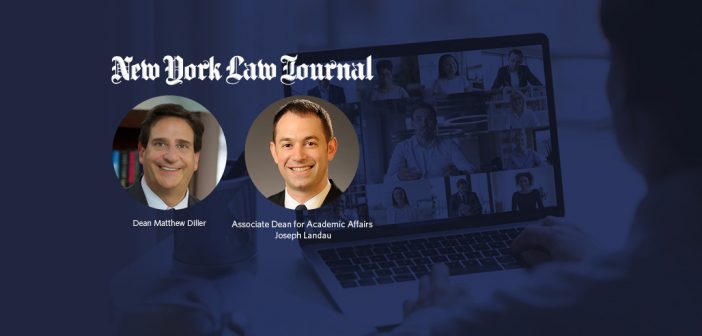The following is a reprint of an op-ed published in the New York Law Journal.
June 29, 2021, at 10:00 AM
This is not a matter of discretion or taste. It is essential to conferring the robust and comprehensive pre-professional education our students rely on us to provide.
By Matthew Diller and Joseph Landau
Even prior to the COVID-19 pandemic, advances in technology had begun to filter into the practice of law. Libraries lined with rows of books were already an endangered species. The pandemic has significantly accelerated these changes, compelling legal institutions not always known to be on the technological cutting-edge to rapidly embrace a suite of new changes. While certain aspects of legal practice will eventually return to pre-pandemic norms, many will not. Some of the changes that already seem likely to outlast the pandemic include virtual litigation tools, remote networking and recruiting, remote collaboration, and the increasing role of artificial intelligence. Taken together, these changes will have a major impact, not only on the practice of law but on the operation of the justice system as whole.
All of this has important implications for legal education. To fulfil our responsibility to best prepare students for the world of law that emerges when the pandemic mercifully subsides, law schools cannot simply hold our collective breath awaiting a return to a pre-pandemic normal that is unlikely to ever materialize. Instead, we must counter these far-reaching changes to the legal industry with meaningful and lasting adjustments of our own.
For law school administrators, this is not a matter of discretion or taste. It is essential to conferring the robust and comprehensive pre-professional education our students rely on us to provide. Law students who become familiar with emerging technologies—who not only become comfortable using them, but understanding their practical relevance in a rapidly evolving legal industry—will be best positioned for professional success. Moreover, law schools should prepare students to be creative and thoughtful thinkers about the risks and opportunities that these changes create for the justice system.
Evolving Litigation Mechanics
One of the most immediate, and lasting, changes the pandemic has wrought has centered around the nuts and bolts of litigation. While lawyers are already beginning to return to courtrooms, litigation by computer is poised to remain widespread even post-pandemic, if only for convenience and to reduce (billable) travel costs. Depositions in particular are likely to continue taking place over Zoom and similar technologies. Judges will also likely continue to employ virtual hearings and conferences.
At this early stage, litigation-by-computer is too nascent to have developed fixed and universal customs. In the absence of such norms, litigators have had the opportunity to rethink a host of practices: When addressing the court, is it appropriate to stand or sit? What advocacy styles translate well to the virtual world and which fall flat? What is more important for the jury to see: Your entire standing body from head to shoes or your eyes? Does that analysis change when addressing only a judge? How do you conduct an effective sidebar during virtual negotiations? In spite of increased physical distance, a well-placed webcam makes it possible to observe the details of a speaker’s face in brand new ways. The paradox is that greater distance has unlocked unprecedented intimacy between advocate, witness, judge and jury. How can lawyers use this intimacy effectively and what risks does it pose? What is the etiquette around texting colleagues during proceedings, which is much more easily masked than passing old fashioned notes. Should certain apps be disabled during court proceedings to ensure that lawyers stay focused and provide effective assistance to their clients?
As these new dynamics influence the courtroom and related dynamics, so too must they permeate any classroom that seeks to prepare students to operate in that courtroom. Law schools must track evolving (and competing) best practices and incorporate them into our litigation classes. Faced with a dearth of virtual courtrooms for budding lawyers to walk past and observe, we must compensate with other opportunities for students to observe, and simulate, virtual litigation.
Career Planning and Development
Just as practitioners and courts are likely to hang onto efficiencies unearthed during the pandemic, so too are legal recruiters and event planners. During the pandemic, law firms have relied almost exclusively on virtual interviews. Similarly, law schools, legal employers, and professional organizations alike have become adept at hosting virtual events. This will of course revert to some degree as the pandemic relents, but the virtual networking format is likely to survive, and students will therefore need to remain primed to succeed in that setting. Consequently, career services offices will be called on to help students adapt to the new normal of virtual job hunting.
Networking has always been essential to obtaining a job, and never more so than in a virtual world—which can be less intuitive for both prospective employees and employers to navigate. On the one hand it is harder to network in a virtual world because there are fewer opportunities for conversation outside of a scheduled meeting. In-person meetings allow one to better pick up on nuances and body language and provide more time for informal chitchat. On the other hand, Zoom networking enables students to easily find and connect with broader networks of employers and alumni anywhere in the world. Career development officers will need to provide guidance for students on how to best harness the technology, and to remain proactive in developing contacts, without forgoing the benefits of in-person connections.
Collaboration, Management and Team-Building
The novel personal and professional challenges posed by an increasingly remote world do not evaporate once employment has been procured. By now, multiple classes of incoming first-years, laterals, and other onboarding attorneys have had to adjust to their new professional digs remotely. That has meant building interpersonal and collaborative relationships, assimilating into an organization’s culture, and learning to navigate institutional hierarchies with little to no in-person contact.
It has also injected further complexity into already-challenging professional landscapes. Subtle interpersonal and behavioral norms for young professionals—for example, when to assert themselves in meetings with partners or clients, or how to initiate contact with a distant senior colleague—can become even trickier in remote settings. When should cameras be on? When should the associate stay muted? When is it appropriate to use chat features and related devices with other meeting participants during the meeting? How does the three-dimensional hierarchy of a law firm translate to a two-dimensional array of Zoom rectangles?
These dynamics have classroom analogs. But law schools must take care to create virtual spaces that build proper habits and skills for communication, collaboration, relationship-building, and self-care in virtual professional settings—not just hierarchical, faculty-dominated educational settings. This will remain true even after in-person instruction is once again the norm.
Artificial Intelligence
Lurking beneath all of these interpersonal changes is the ever-intensifying rise of artificial intelligence in the legal world. Artificial intelligence’s legal footprint has been expanding for years—a trend that has accelerated during the pandemic. Companies and law firms are increasingly using these tools to predict the outcome of pending litigation, bolster discovery efforts, and aid in legal research—among numerous other uses.
As always, law schools must anticipate, and respond to, changes in the legal industry. Administrators must ensure their graduates are familiar with the extent to which artificial intelligence is changing the practice of law. On a skills level, we must facilitate students’ exposure to process and project management tools, as well as the various software platforms that increasingly power day-to-day discovery, due diligence, and contract review in the industry.
Thinking Systemically
As remote interactions become normalized and incorporated in a wide range of the interactions that comprise so much of the practice of law, it is important to focus on the big-picture questions about our justice system: What opportunities do remote lawyering and remote proceedings have to expand access to justice in our society? Do the advantages of remote environments also pose risks that individuals and clients will just be processed through an online bureaucratic mill? To what extent do online environments improve, or worsen, concerns about inclusion and bias as compared with face-to-face interactions? Law schools must ensure that we are educating lawyers who will keep these and other questions in mind so that we can work toward ensuring that our legal system is truly a system of justice.
Conclusion
Above all, we must instill in our students the ability to remain nimbler than ever before. Seismic societal forces have compelled, and will continue to compel, legal organizations to rapidly evolve in order to take advantage of new, fast developing practice areas. Lawyers entering the business, government, and non-profit sectors must be primed to tackle similar challenges. A well-rounded law school graduate versed in a variety of practice areas may have an advantage over a highly specialized graduate.
The rapidly changing world that legal graduates face may seem daunting, but it also encompasses significant opportunity for those who are well-prepared to enter it. The increased role of technology in the provision of legal services is creating new avenues to increase access to justice for people throughout the country, particularly in isolated areas. It is empowering courts with tools to better manage their immense caseloads. It is allowing law firms to cater to their client’s needs more efficiently. And it is fostering new conversations, and new mechanisms, to ensure that professional and educational environments be structured to ensure mutual respect, understanding, and inclusion.
It is, therefore, the responsibility of law schools to ensure their graduates are equipped to avail themselves of these opportunities. No doubt, much of our traditional, substantive curriculum will remain as essential as it has ever been. But adherence to tradition should not be a stumbling block to meeting new challenges and facing new realities. As the industry that our students entrust us to prepare them for swiftly evolves, legal educators must keep pace, ensuring that we are giving our students the best possible training for successful and satisfying careers.
Matthew Diller is the dean and Joseph Landau is the associate dean for academic affairs at Fordham Law School.




